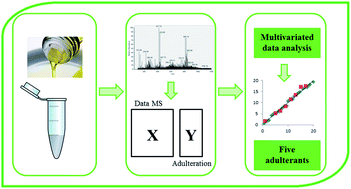Multivariate calibration applied to ESI mass spectrometry data: a tool to quantify adulteration in extra virgin olive oil with inexpensive edible oils
Abstract
Constant supervision is required to ensure the quality control in extra virgin olive oil, a quite expensive product with worldwide consumption. In this paper, a rapid, simple and efficient method based on the application of the partial least squares (PLS) approach to electrospray ionization mass spectrometry (ESI-MS) data was developed for determining adulteration of extra virgin olive oil with four adulterant oils (soybean, corn, sunflower and canola). Each model was built with 40 adulterated samples (from 0.5 to 20.0% w/w), which were prepared using commercial oils. These models presented root mean square errors of prediction of 1.7% w/w for soybean, 1.0% w/w for corn, 1.4% w/w for sunflower and 1.0% w/w for canola. The methods were subjected to a complete multivariate analytical validation in accordance with the Brazilian and international guidelines, and were considered accurate, linear, sensitive and unbiased. So, it can be envisaged that this methodology has the potential to be applied in quality control of extra virgin olive oil samples.

- This article is part of the themed collection: Analytical Sciences in Brazil

 Please wait while we load your content...
Please wait while we load your content...